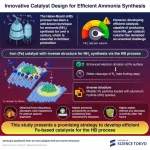(Press-News.org) In a paper recently published in the leading journal "The Lancet Digital Health", a scientific team led by Stanisa Raspopovic from MedUni Vienna looks at the progress and challenges in the research and development of brain implants. New achievements in the field of this technology are seen as a source of hope for many patients with neurological disorders and have been making headlines recently. As neural implants have an effect not only on a physical but also on a psychological level, researchers are calling for particular ethical and scientific care when conducting clinical trials.
The research and development of neuroprostheses has entered a phase in which experiments on animal models are being followed by tests on humans. Only recently, reports of a paraplegic patient in the USA who was implanted with a brain chip as part of a clinical trial caused a stir. With the help of the implant, the man can control his wheelchair, operate the keyboard on his computer and use the cursor in such a way that he can even play chess. About a month after the implantation, however, the patient realised that the precision of the cursor control was decreasing and the time between his thoughts and the computer actions was delayed. "The problem could be partially, but not completely, resolved - and illustrates just one of the potential challenges for research into this technology," explains study author Stanisa Raspopovic from MedUni Vienna's Center for Medical Physics and Biomedical Engineering, who published the paper together with Marcello Ienca (Technical University of Munich) and Giacomo Valle (ETH Zurich). "The questions of who will take care of the technical maintenance after the end of the study and whether the device will still be available to the patient at all after the study has been cancelled or completed are among the many aspects that need to be clarified in advance in neuroprosthesis research and development, which is predominantly industry-led."
Protection of highly sensitive data
Neuroprostheses establish a direct connection between the nervous system and external devices and are considered a promising approach in the treatment of neurological impairments such as paraplegia, chronic pain, Parkinson's disease and epilepsy. The implants can restore mobility, alleviate pain or improve sensory functions. However, as they form an interface to the human nervous system, they also have an effect on a psychological level: "They can influence consciousness, cognition and affective states and even free will. This means that conventional approaches to safety and efficacy assessment, such as those used in clinical drug trials, are not suitable for researching these complex systems. New models are needed to comprehensively evaluate the subjective patient experience and protect the psychological privacy of the test subjects," Raspopovic points out.
The special technological features of neuroimplants, in particular the ability to collect and process neuronal data, pose further challenges for clinical validation and ethical oversight. Neural data is considered particularly sensitive and requires an even higher level of protection than other health information. Unsecured data transmission, inadequate data protection guidelines and the risk of hacker attacks are just some of the potential vulnerabilities that require special precautions in this context. "The use of neural implants cannot be reduced to medical risks," summarises Stanisa Raspopovic. "We are only in the initial phase of clinical studies on these technological innovations. But questions of ethical and scientific diligence in dealing with this highly sensitive topic should be clarified now and not only after problems have arisen in test subjects or patients."
END
Progress and challenges in brain implants
Research team calls for special ethical and scientific care
2025-01-24
ELSE PRESS RELEASES FROM THIS DATE:
City-level sugar-sweetened beverage taxes and changes in adult BMI
2025-01-24
About The Study: Sugar-sweetened beverage (SSB) excise taxes were associated with reduced mean body mass index (BMI) among adults in demographic subgroups, including in young adults who consumed the most SSBs, and in Berkeley, in this cohort study. Future research should examine the mechanisms of these associations to inform how SSB taxes could be more equitable for weight-related outcomes.
Corresponding Author: To contact the corresponding author, Emily F. Liu, MPH, email emily.f.liu@kp.org.
To access the embargoed study: Visit our For The Media website at this link https://media.jamanetwork.com/
(doi:10.1001/jamanetworkopen.2024.56170)
Editor’s ...
Duration in immigration detention and health harms
2025-01-24
About The Study: In this cross-sectional study, detained immigrants experienced a high prevalence of poor health, mental illness, and posttraumatic stress disorder (PTSD), with detention periods of 6 months or more associated with higher rates compared with those detained less than 6 months. Duration of custody is one mechanism by which immigration detention might be a catalyst for worsening health.
Corresponding Author: To contact the corresponding author, Altaf Saadi, MD, MSc, ...
COVID-19 pandemic and racial and ethnic disparities in long-term nursing home stay or death following hospital discharge
2025-01-24
About The Study: Older adults hospitalized with sepsis experienced an approximately 50% reduction in long-term nursing home stay or death over a 5-year period before the pandemic in this cross-sectional study. These results suggest that during the pandemic, all individuals, regardless of race and ethnicity, experienced increased long-term nursing home stay or death compared with before the pandemic.
Corresponding Author: To contact the corresponding author, Laurent G. Glance, MD, email laurent_glance@urmc.rochester.edu.
To access the embargoed study: Visit our For The Media website at this link https://media.jamanetwork.com/
(doi:10.1001/jamanetworkopen.2024.56816)
Editor’s ...
Specific types of liver immune cells are required to deal with injury
2025-01-24
Ghent, 24 January 2025 – Our livers contain many different types of immune cells. New research by the team of Prof. Charlotte Scott (VIB-UGent Center for Inflammation Research) and colleagues now reveals that a specific activation state of one of these cell types is required for tissue repair following injury. This suggests these cells may be useful as new therapeutic targets for various liver conditions. The work appears in the journal Immunity.
Liver immune cells
Macrophages are specialized immune cells located in every tissue ...
How human activity has shaped Brazil Nut forests’ past and future
2025-01-24
The significant decline in genetic diversity in the Amazon Basin, following historical events such as European colonisation, deforestation and the extinction of megafauna such as the sloth – the main seed dispersal agents, is of particular concern for the genetic health of Brazil Nut trees (Bertholletia excelsa). As one of the most impacted keystone species in rainforests, Brazil Nut trees are essential for biodiversity and a vital income source for local economies.
A crucial study led by researchers from the Max Planck Institute of Geoanthropology and the Max Planck Institute for Biology Tübingen ...
Doctors test a new way to help people quit fentanyl
2025-01-24
During the COVID-19 pandemic, when fentanyl overdoses surged, doctors were desperate to find ways of helping their patients.
They knew that buprenorphine could help people stop using opioids, but it was much harder to start the treatment for those who used fentanyl, which lasts longer in the body. Taking buprenorphine while fentanyl is still active can push someone abruptly into withdrawal.
So, they started giving patients small doses of the drug over a series of days to slowly build up the drug in their systems until their bodies could handle a higher dose of buprenorphine.
Now, ...
Long read sequencing reveals more genetic information while cutting time and cost of rare disease diagnoses
2025-01-24
One in every 10 people worldwide is impacted by a rare genetic disease but about 50% of them remain undiagnosed despite rapid increases in genetic technology and testing. Even when a person does have access to testing, the process of getting a diagnosis can take about five years or more, which is sometimes too late for patients, who are often children, to start the right treatment.
This is partly because current clinical testing uses a method called short-read sequencing, which cannot access information in certain regions of the genome and so may miss ...
AAAS and ASU launch mission-driven collaborative to strengthen scientific enterprise
2025-01-24
Today, the American Association for the Advancement of Science and Arizona State University announced a five-year partnership, the AAAS + ASU Collaborative. Together, the institutions will elevate and amplify strategies and practices that advance scientific excellence and enable a boldly inclusive scientific enterprise serving society.
In its first phase, the Collaborative includes a joint prize, an invitation for the ASU STEMM community to join AAAS as Elemental Members, and events in Washington, D.C., addressing policy-relevant science topics.
“Focusing science and scientific advances on the challenges we face is essential to the advancement ...
Medicaid-insured heart transplant patients face higher risk of post-transplant complications
2025-01-24
A new study led by UCLA Health highlights the link between socioeconomic disadvantage, Medicaid insurance, and poorer survival rates after heart transplantation. Researchers found that Medicaid-insured heart transplant patients had a higher likelihood of developing cardiac allograft vasculopathy (CAV), a condition that affects transplanted hearts and can limit long-term survival. It has been reported that CAV contributes to more than 30% of all deaths in the first 5 to 10 years following heart transplantation.
The study, which included heart transplant recipients aged 18 and older, divided ...
Revolutionizing ammonia synthesis: New iron-based catalyst surpasses century-old benchmark
2025-01-24
NH3 is one of the most important chemicals in today’s world, as it is used in the production of fertilizers to boost agricultural yields and sustain the ever-growing global population. For over 100 years, NH3 production has relied on the Haber–Bosch (HB) process, which combines nitrogen (N2) and hydrogen in the presence of a catalyst. Interestingly, an iron-based catalyst developed a century ago (called ‘Promoted-Fe’) still remains at the forefront of mass NH3 production, despite countless efforts to find more energy-efficient alternatives. In the HB process, where NH3 is produced by a catalyst-filled reactor with a limited volume, ...
LAST 30 PRESS RELEASES:
Exploring how the visual system recovers following injury
Support for parents with infants at pediatric check-ups leads to better reading and math skills in elementary school
Kids’ behavioral health is a growing share of family health costs
Day & night: Cancer disrupts the brain’s natural rhythm
COVID-19 vaccination significantly reduces risk to pregnant women and baby
The role of vaccination in maternal and perinatal outcomes associated with COVID-19 in pregnancy
Mayo Clinic smartwatch system helps parents shorten and defuse children's severe tantrums early
Behavioral health spending spikes to 40% of all children’s health expenditures, nearly doubling in a decade
Digital cognitive behavioral treatment for generalized anxiety disorder
Expenditures for pediatric behavioral health care over time and estimated family financial burden
Air conditioning in nursing homes and mortality during extreme heat
The Alps to lose a record number of glaciers in the next decade
What makes a good proton conductor?
New science reporting guide published for journalists in Bulgaria
New international study reveals major survival gaps among children with cancer
New science reporting guide published for journalists in Turkey
Scientists develop a smarter mRNA therapy that knows which cells to target
Neuroanatomy-informed brain–machine hybrid intelligence for robust acoustic target detection
Eight SwRI hydrogen projects funded by ENERGYWERX
The Lundquist Institute and its start-up company Vitalex Biosciences Announces Strategic Advancement of Second-Generation fungal Vaccine VXV-01 through Phase 1 Trials under $40 Million Competitive Con
Fine particles in pollution are associated with early signs of autoimmune disease
Review article | Towards a Global Ground-Based Earth Observatory (GGBEO): Leveraging existing systems and networks
Penn and UMich create world’s smallest programmable, autonomous robots
Cleveland researchers launch first major study to address ‘hidden performance killer’ in athletes
To connect across politics, try saying what you oppose
Modulating key interaction prevents virus from entering cells
Project explores barriers to NHS career progression facing international medical graduates
Jeonbuk National University researchers explore the impact of different seasonings on the flavor perception of Doenjang soup
Two Keck Medicine of USC Hospitals named Leapfrog Top Teaching Hospitals
World-first discovery uncovers how glioblastoma tumours dodge chemotherapy, potentially opening the door to new treatments
[Press-News.org] Progress and challenges in brain implantsResearch team calls for special ethical and scientific care


